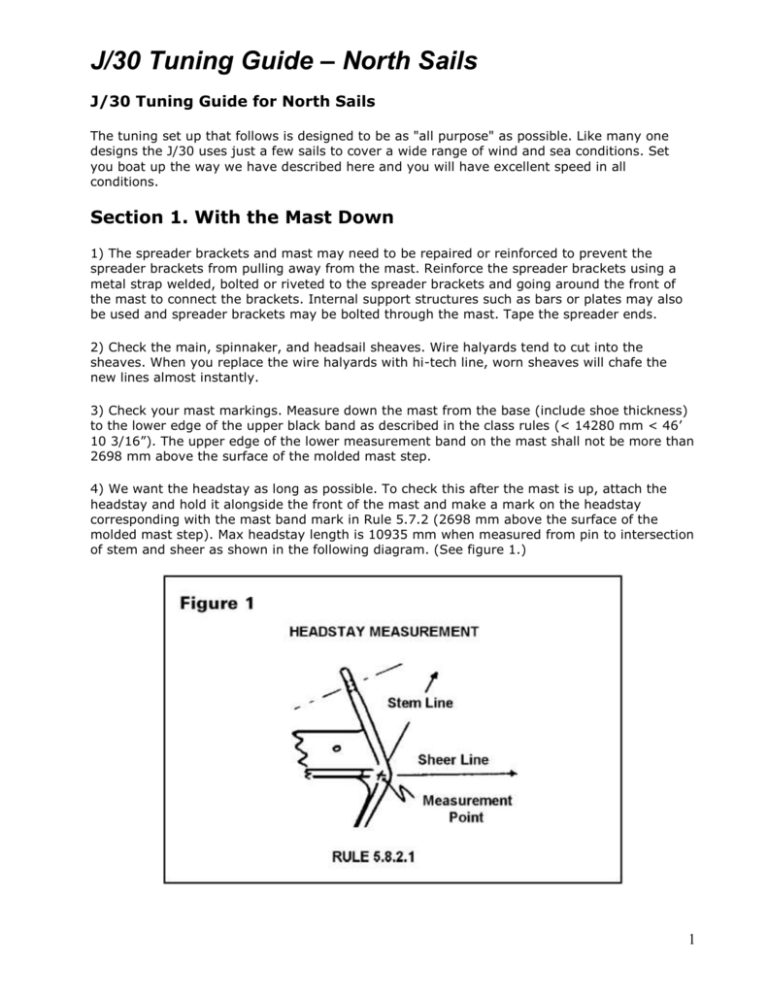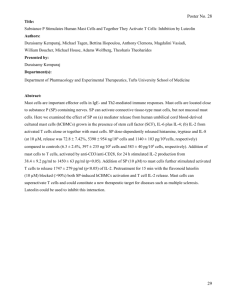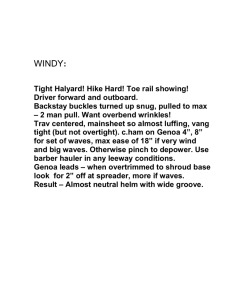J-30 Tuning Guide
advertisement

J/30 Tuning Guide – North Sails J/30 Tuning Guide for North Sails The tuning set up that follows is designed to be as "all purpose" as possible. Like many one designs the J/30 uses just a few sails to cover a wide range of wind and sea conditions. Set you boat up the way we have described here and you will have excellent speed in all conditions. Section 1. With the Mast Down 1) The spreader brackets and mast may need to be repaired or reinforced to prevent the spreader brackets from pulling away from the mast. Reinforce the spreader brackets using a metal strap welded, bolted or riveted to the spreader brackets and going around the front of the mast to connect the brackets. Internal support structures such as bars or plates may also be used and spreader brackets may be bolted through the mast. Tape the spreader ends. 2) Check the main, spinnaker, and headsail sheaves. Wire halyards tend to cut into the sheaves. When you replace the wire halyards with hi-tech line, worn sheaves will chafe the new lines almost instantly. 3) Check your mast markings. Measure down the mast from the base (include shoe thickness) to the lower edge of the upper black band as described in the class rules (< 14280 mm < 46’ 10 3/16”). The upper edge of the lower measurement band on the mast shall not be more than 2698 mm above the surface of the molded mast step. 4) We want the headstay as long as possible. To check this after the mast is up, attach the headstay and hold it alongside the front of the mast and make a mark on the headstay corresponding with the mast band mark in Rule 5.7.2 (2698 mm above the surface of the molded mast step). Max headstay length is 10935 mm when measured from pin to intersection of stem and sheer as shown in the following diagram. (See figure 1.) 1 J/30 Tuning Guide – North Sails 5) Before stepping the mast, move the forward edge of the mast butt shoe 25mm (1”) from the molded mast step per Rule 5.7.3 Section 2. Mast Up Step the mast and attach all shrouds (except the backstay) very loosely. Leave any mast blocks out for the moment. 1) Next we need to make sure that the mast is positioned as far aft at deck level as possible. Have a friend hold the end of your tape at the stem measurement point and measure again straight to the forward edge of the mast. We want this measurement to be as close to maximum as possible, Stem to front of mast (J) 3505 +/- 13mm, (11' 6” +/- 1/2”) per Rule 5.7.3. Chock the mast at the deck to hold it in this position. See figure #1 to determine measurement point at stem. 2) Get the mast and the keel in line. It’s important to get the mast and the keel on the same vertical plane. If the boat is out of the water, (the boat does not have to perfectly level) place a ladder approx. 100 feet behind the boat. The ladder must be placed directly behind the boat (as close to the extenuation of centerline of the boat as possible). Next tie a string from the top rung of the ladder to a low rung. Accurately, align the string with the trailing edge of the keel then sight up the string to the top of the mast (adjust the string horizontally on the latter rungs). Ultimately the top of the mast and the sail grove should be in line with the trailing edge of the keel. This should all be done with no blocks in at the partners. To get a proper sight put one knee down and try and stabilize your body as much as possible than just use one eye to glance up to the top of the mast and back down to the keel. Having a friend with you to confirm what you are seeing is not a bad idea. When you are confident that the mast and the trailing edge of the keel are on the same vertical plane then check to make sure that you are at the max J dimension. Now you are ready to put the mast partner blocks in. If the boat is in the water, center the mast by tighten the upper shrouds to ___ on a Loos Model B tension gauge and the lowers to ___. We get the uppers snug first and then using a metal tape measure attached to the main halyard measure down to the rail adjacent to the chainplates on both sides. The measurement should be the same on both sides to be sure the mast is centered in the boat. Be sure to sight up the backside of the mast to be sure the mast is not bowed. If bowed, adjust one or the other lower shrouds to straighten the mast. At this point your mast should be set up with __- ___" of prebend in the mast. To check this simply hold the main halyard at the gooseneck and sight up the backside of the mast. If this is not the case you’ll need to go back and recheck your measurements. Section 3. Tuning Chart As we mentioned before, the J/30 has just 5 sails to cover the entire wind range the boat is raced in. The Number 2 Genoa is seldom used. For the best performance in each condition we adjust the tension on the shrouds depending on how much wind there is. As the final step in setting up your boat fill in the attached tuning chart with how many turns of the turnbuckles it take to get from one setting to another. Counting turns allows adjustment of the shroud tension during races when it is impossible to the get accurate Loos readings with the sails up and the boat in waves. 2 J/30 Tuning Guide – North Sails Rig Settings Old Loos Gauge Model B Wind BASE Uppers Lower Tension Tension 0-5 ____ ____ 6-9 ____ ____ 10-13 ____ ____ 14-17 ____ ____ 18+ ____ ____ BASE New Loos Gauge Pro Model PT2 Wind Uppers Lower Tension Tension 0-5 ____ ____ 6-9 ____ ____ BASE 10-13 1500 1000 14-17 ____ ____ 18+ ____ ____ BASE Special note on the backstay: As you adjust the tension of your lower shrouds you’ll notice the backstay gets tighter or looser. Each time you adjust your shrouds be sure to adjust the two smaller backstay turnbuckles so that the blocks riding on the backstay bridles stay 6-8" below the "y' in the backstay when the tension is off. This is very important to make sure the headstay can get tight and loose enough depending on the conditions. Sail Trim: Follow these guidelines to set up and trim your sails. Mainsail: Outhaul: From the clew to the mast black band: Wind 6-9 10-13 14-17 18+ Inches ____ ____ ____ ____ Cunningham: No cunningham until about 12 knots, then tension until wrinkles in luff are just removed. 3 J/30 Tuning Guide – North Sails Vang: Upwind keep loose to 8 knots then tension to remove all slack above that. Above 15 knots tension very hard so boom does not rise at all when the mainsheet is eased. Downwind tension so top batten is parallel to boom. Traveler: Keep all the way up on weather side until crew is all sitting out on weather side with legs out. As soon as crew is on weather rail with legs over, drop down 2". Then drop it down as far as the middle of the track to keep the boat flat. If you have to drop below middle to keep boat flat put on some backstay and keep traveler in the middle. Play traveler in puffs to keep boat flat as wind builds. We do not like to sail with traveler below ¾'s of the way down. Backstay: Use to control fullness on main and genoa. Leave loose until about 8 knots. Slowly tighten as breeze builds to depower boat. At it's tightest, it will be all the way down to the top of the pushpit. A small adjustment (1-2") can have a big effect here. Be sure to adjust the backstay turnbuckles when adjusting the side shrouds. Mainsheet: Tension mainsheet so top batten is parallel to the boom and the top telltale is flying 50-60% of the time up to 10 knots of wind. Above that the top telltale should be flying all the time because now the top of the main will be flatter. Mainsail Setting Chart Wind Speed Traveler Backstay Top batten angle Outhaul 0-6 knots All way up None Closed 3 degrees In 1/2" 7-12 Down 3-4" 1/4 on Closed 3 degrees to parallel Max tight 12-18 Middle 1/2 to 3/4 on Parallel to open 3 degrees Max tight 18+ Below CL 2-3" Max on Open 3-6 degrees Max tight Genoa set up: With the genoa there are three major things we are concerned with, having the lead in the proper position, having the genoa halyard set right and getting the sheet tension right. Halyard Tension: We want to the halyard set so the luff of the genoa has just a hint of wrinkles in it. The reason is that we have found that it is better to have the halyard too loose rather than too tight. In light air we want to be sure that the luff is nice and loose. As the wind builds, we tension the halyard enough that the cloth along the luff of the genoa is smooth. It is important to have a mark for your genoa halyard near the stopper to keep it in position. We mark off ½" increments to make it easier to duplicate fast settings. Also mark the sail luft at the mark on the headstay that corresponds to the lower mast band mark (see Section 1 #4). 4 J/30 Tuning Guide – North Sails Lead Position: Note that it is important that you have drilled out an extra set of holes between each of the factory-drilled holes in your genoa track. The standard spacing is too far apart to be workable. Having the lead in the correct position is critical for good speed. In moderate breeze (4-8 knots), trim the sail in and position the lead car so that the sail touches the spreader and the chainplates or turnbuckles at exactly the same time. Mark this position. This will be your neutral point for your jib lead. Sheet Tension: We check the sheet tension by judging how many inches the sail is trimmed away from the end of the spreader. Generally we never trim the sail tighter than 1" from the end of the spreader. Genoa Setting Chart Condition Lead Halyard Sheet 0-6 flat 1 aft of neutral Wrinkles 3-4" off spreader 0-6 choppy On Neutral Wrinkles 3-6" off spreader 7-13 flat On Neutral Just Smooth 2-3" off spreader 7-13 choppy 1-2 holes fwd. Wrinkles 2-4" off spreader 14-18 choppy 1-2 holes fwd. Smooth 4-6" off spreader 18+ On neutral Tight 6-8" off spreader As the above chart shows it is important to change your settings depending on the condition. Be aware that as the wind builds and dies you will need to be constantly adjusting the tension on the genoa sheet. Class Jib Trim: Lead Position: Drill two extra holes between each set of factory holes in the jib track. Start with the jib lead block positioned at the chainplates and fine tune the lead position from there. Halyard Tension: Unlike the genoa the luff of the jib should always be smooth. Be careful, you can in moderately heavy air get the luff too tight. The luff of the sail should break evenly up and down. If the sail breaks high first move the lead forward, low first move the lead back. Check this carefully and make a mark on the deck in the correct spot. Also mark the sail luft at the mark on the headstay that corresponds to the lower mast band mark (see Section 1 #4). 5 J/30 Tuning Guide – North Sails Jib Sheet: Sheet tension is critical. We like to adjust the tension on the jib sheet to balance out the helm of the boat. If the boat has a bit of weather helm trim the jib slightly to pull the bow down. If the boat has leeward helm ease the jib slightly. Keep in mind that you only need to change the tension on the sheet very slightly (1/2" increments) to have a real effect on the trim of a high aspect sail like the jib. Spinnaker Trim The spinnaker should be at full hoist at all times. The general rule of trim is to allow 2-4" (50102 mm) of curl in the luff of the sail. The ends of the pole should be even with the free floating clew and the pole should remain perpendicular to the apparent wind. If you are going slow try raising the pole a couple of inches. Downwind-light air: Concentrate on good communication between helmsman and spinnaker trimmer. The goal is to sail as low as possible while still maintaining good pressure in the spinnaker (measured by tension on the sheet). Try not to sail too high which translates into longer distances, but do not sail too low at a slow pace. Be careful not to pull the pole too far aft which flattens the spinnaker. Downwind-heavy air: Be careful not to square the pole back too far as this makes it easier for the spinnaker to roll out to weather. Do not let the clew of the spinnaker go past the headstay. Keep most of the crew hiked on the leeward side in order to sail low and not risk rolling to weather. Downwind tips: 1. Pole height is important and changes in increments of 1" (25 mm) have a big effect on the spinnaker. The break in the sail should curl evenly from top to bottom. If the spinnaker breaks high, the pole is too low and should be raised. If the break is low, the pole is too high and should be lowered. 2. Whether or not you use tweakers (or twings), an efficient foreguy system is crucial. Every up and down, or back and forth motion of the pole (and hence the spinnaker) is wasted energy; that energy will not be pulling the boat forward. 3. An efficient system for launching and retrieving the spinnaker is a must. We recommend a rail mounted launching bag, or launching from the v-berth hatch. Call us if you would like a launching bag made for your J/30. In conclusion: Always sail the boat as flat as possible except for very light air Sail as close to max weight limit of 1400 lbs as possible see Rule 6.7.1. Do not be afraid to change settings if you are slow. Keep a tuning chart and use it. Have open positive communication on board. Sail fast and have fun! 6 J/30 Tuning Guide – North Sails For tuning help, contact the North J/30 experts. 7





